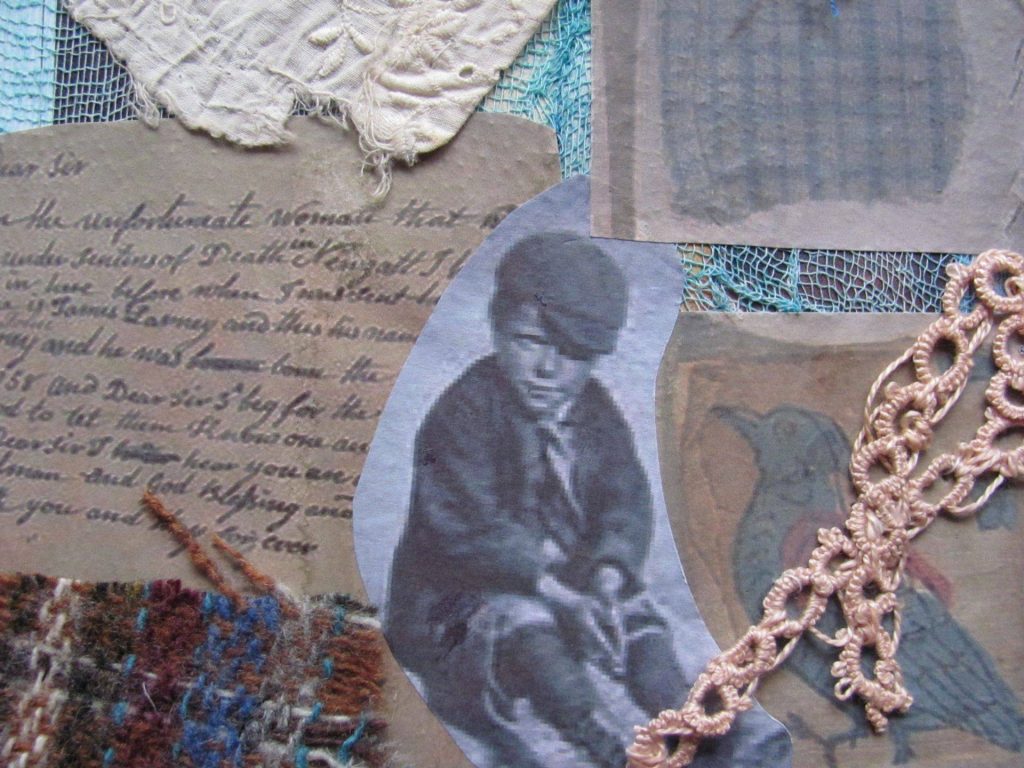The Idea
For this mixed media project I took a discarded Victorian Anthology which is a beautiful book full of pieces of poetry and prose alongside lovely images from the Victorian era. But it’s a view of Victorian Britain that could only be enjoyed by the privileged.



Browsing in this book made me think about what life was for the vast majority of people and it inspired me to alter this book by inserting some other sections to balance out this rather rosy view. I have completed two: “Poverty and the Foundling Hospital”, and “The Workhouse”. I am currently working on “Literacy and Education” and have plans to do at least another two sections: “At Leisure” and “The Dust Heap”.
Poverty and the Foundling Hospital

Reproduction of a drawing of the original Foundling Hospital in London opened by CaptainThomas Coram in 1739. He had campaigned for 19 years to set up an institution dedicated to the care and education of ‘foundlings’, the children he saw abandoned on London’s streets.
I have used this image to make an “open out” section in the book.
The Foundling Hospital took children in from1739-1954 and over the centuries, more than 25,000 children’s lives were saved.
Mothers brought their babies to the Foundling Hospital to be cared for, with many hopeful that their financial circumstances would change so they could one day reclaim them. Every child admitted to the Foundling Hospital was baptised and given a new name. Mothers also left a token which could be used to identify their child if they returned to reclaim their child.

When the pages are opened out from the centre, they reveal images of Victorian children and reproductions of some of the original letters that were written to the hospital or individual children.
At the sides are images of the original “Maps Descriptive of London Poverty” which were researched and drawn up by Charles Booth between 1886 and 1903

I have added scraps of vintage fabrics, lace and ribbons to represent the tokens left with the children by their mothers.

Around the edges I have inserted luggage labels with images of Victorian children to represent their manner of arrival at the Foundling Hospital
The Workhouse
In England and Wales a workhouse was a place where those unable to support themselves could find accommodation and employment. Life in a workhouse was intended to be harsh, to deter the able-bodied poor and to ensure that only the truly destitute would apply. But in areas such as the provision of free medical care and education for children, neither of which was available to the poor in England living outside workhouses until the early 20th century, workhouse inmates could be said to be advantaged over the general population.
However, many feared the Workhouse as it was the absolute last resort, from which many never returned.

Here, I have painted the pages with black, grey and brown paint, typical of a workhouse interior. I have used images of people from a workhouse and text from old papers and a dictionary, picking words, phrases and dictionary definitions to describe the conditions.

Most of the uniforms provided for inmates was brown or beige. In some workhouses, women were made to wear yellow if they were an unmarried mother and red if they were a prostitute, although this stigmatisation was later outlawed.
